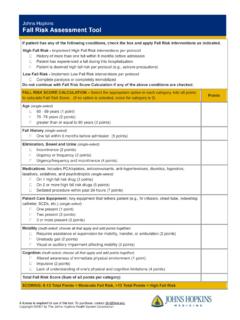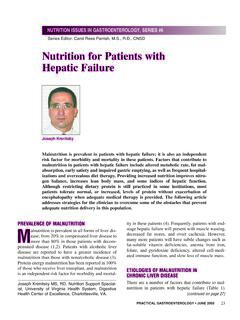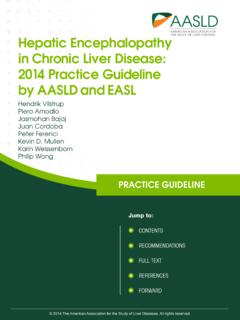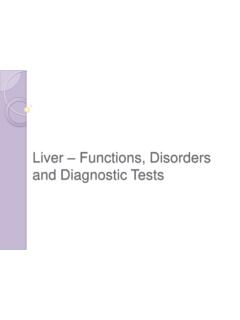Transcription of Viral Hepatitis B: Introduction - Hopkins Medicine
1 Figure 1. Location of the liver in Hepatitis B: Introduction Viral Hepatitis ," refers to infections that affect the liver and are caused by viruses. It is a major public health issue in the UnitedStates and worldwide. Not only does Viral Hepatitis carry a high morbidity, but it also stresses medical resources and can havesevere economic consequences. The majority of all Viral Hepatitis cases are Hepatitis includes five distinct disease entities, which are caused by at least five different viruses. Hepatitis A and Hepatitis B(infectious and serum Hepatitis , respectively) are considered separate diseases and both can be diagnosed by a specificserologic test. Hepatitis C and E comprise a third category, each a distinct type, with Hepatitis C parenterally transmitted, andhepatitis E enterically transmitted.
2 Hepatitis D, or delta Hepatitis , is another distinct virus that is dependent upon Hepatitis Binfection. This form of Hepatitis may occur as a super-infectionin a Hepatitis B carrier or as a co-infection in an individual withacute Hepatitis B. Hepatitis viruses most often found in the United States include A, B, C, and fatality from Hepatitis is relatively low, mortality figures are a poor indicator of the actual incidence of these diseases. TheCenters for disease Control and Prevention estimated that approximately 400,000 600,000 people were infected with viralhepatitis during the decade of the plagued mankind as early as the fifth century BC. It was referenced in early biblical literature and described as occurringin outbreaks, especially during times of war.
3 Toward the end of the nineteenth century, Hepatitis was thought to occur as a resultof infection of the hepatic parenchyma. The infectious nature of Hepatitis was established after World War II. In the mid-1960s,Blumberg and colleagues discovered the surface antigen and antibody of Hepatitis B. This Nobel Prize-winning research openedthe door to our appreciation of the morphological and immunochemical features of other forms of Viral Hepatitis . What is Hepatitis B? chronic Hepatitis B virus (HBV) is the ninth leading cause of death, with approximately 300 million chronic carriers of HBV worldwide. In the United States there arean estimated million chronic carriers, accounting for roughly 17,000 hospitalizations and 5,500 deaths each year. Hepatitis B belongs to the hepadnaviridae classof viruses.
4 It is transmitted by direct percutaneous or permucosal exposure to infected blood. The Hepatitis B infection occurs in adolescents and adults and can leadto acute Hepatitis , subclinical infection, or the development of chronic infection. The incubation period ranges from 45 160 days, with an average of 75 days, followedby an insidious onset of acute disease (Figure 2). Figure 2. Morphology of Hepatitis B virus. M, L, S, envelope is a small, partially double-stranded DNA genome ( kb) encoding four genes HBsAg (surface envelope glycoprotein), HBcAg ( Viral capsid protein), HBVPol/RT (polymerase reverse transcriptase), and X gene (transcriptional activator) (Figure 3). Figure 3. Genomic organization of Hepatitis B are four major serologic types of Hepatitis B virus (adw, ayw, adr, and ayr), with different geographic distributions.
5 The clinical significance of the four typesremains unclear. Common to all of these subtypes, however, is an immuno-dominant epitope, the a determinant, that is the target of a neutralizing antibody inhepatitis B Viral infection (anti-HBsAg). Recently, mutations in the a determinant have been reported to be associated with recurrence of Hepatitis B viremia in serumdespite the presence of protective antibodies (anti-HBsAg).The life cycle of the Hepatitis B virus is depicted in the animation (Figure 4). The development of clinical Hepatitis in HBV-infected individuals is age dependent. Fewer than 10% of infected infants will develop clinical Hepatitis compared with34% of adults 30 years of age or older. About 5 10% of HBV-infected adults will develop a chronic infection with HBV DNA in the liver and antigenemia (having theantigen in the blood).
6 chronic infection almost always occurs in patients infected in the first few months of life, and may remain for many years or a with chronic Hepatitis B infection are at high risk for serious health complications. Approximately 15 25% of this group will die prematurely fromhepatocellular carcinoma or cirrhosis . SymptomsViral Hepatitis may develop without clinical signs or symptoms, or with nonspecific symptoms that may appear for a short time with or without jaundice. Thesesymptoms may vary from nonspecific flu-like indications to fatal liver failure. Diagnosis of Viral Hepatitis often depends on an accumulation of findings consideredtogether (Figure 5). Figure 5. Possible outcomes after Hepatitis B infection; A, acute infection; B, chronic in the disease process, generally called the prodromal phase, some patients experience a serum-type sickness that may include fever, arthralgia , arthritis ,rash, and angioneurotic edema.
7 These symptoms usually occur 2 3 weeks before jaundice and generally subside before jaundice develops, although they may beconcomitant with its the pre-icteric phase, patients may experience respiratory and gastrointestinal tract symptoms, including malaise, fatigue, myalgia, anorexia , nausea, and/orvomiting. They may also experience moderate weight loss, headache, coryza , fever, or pharyngitis and cough. Many patients complain of mid-epigastric pain, rightupper quadrant discomfort, or diarrhea. Also characteristic of this phase is the development of dark urine and the lightening of stool color. This duration of this stage ofthe disease may range from 2 3 days to 2 3 icteric phase is signaled by the development of jaundice. General constitutional symptoms may subside.
8 There may be worsening of anorexia, nausea, andvomiting along with scratching and irritated skin lesions related to pruritis. Copyright 2001-2013 | All Rights North Wolfe Street, Baltimore, Maryland 21287 Viral Hepatitis B: Anatomy The liver is located in the right upper quadrant, from the fifth intercostals space in the midclavicular line down to the right costal margin. The liver weighsapproximately 1800 g in men and 1400 g in women. The surfaces of the liver are smooth and convex in the superior, anterior, and right lateral regions. Indentationsfrom the colon, right kidney, duodenum, and stomach are apparent on the posterior line between the vena cava and gallbladder divides the liver into right and left lobes. Each lobe has an independent vascular and duct supply.
9 The liver is furtherdivided into eight segments, each containing a pedicle of portal vessels, ducts, and hepatic veins (Figure 6). Figure 6. A, Normal gross anatomy of the liver ; B, B', histological view. Copyright 2001-2013 | All Rights North Wolfe Street, Baltimore, Maryland 21287 Viral Hepatitis B: Causes Overview Risk factors for Hepatitis B include multiple sexual partners, injection drug use, household contact, and health care employment. Infections may be acquiredperinatally or during early childhood. Perinatal or early infection have declined as a result of passive immunization with HBV immune globulin in high-risk situationsand the initiation of universal HBV vaccination at birth. Infection control practices, changes in blood donation screening, and blood transfusion protocols have alsocontributed to the decline in the incidence of Hepatitis virus is transmitted parenterally, typically by transfusion of contaminated blood or blood products, or by injection drug use (shared needles).
10 Health care workerswho are exposed to blood are at increased risk of infection. In addition, staff in facilities for the developmentally disabled have an increased risk of spread can also occur between both heterosexual and homosexual partners with heterosexual activity being the most common risk factor. Manycases of acute Hepatitis B occur sporadically without any known the United States, Hepatitis B Viral infection occurs primarily in adults and adolescents. In Asian countries, the infection occurs most often during childhood throughchild-to-child or mother-to-child transmission. Copyright 2001-2013 | All Rights North Wolfe Street, Baltimore, Maryland 21287 Viral Hepatitis B: Diagnosis Acute InfectionThe incubation period for Hepatitis B from acute exposure to clinical symptoms may range from 60 180 days.
















